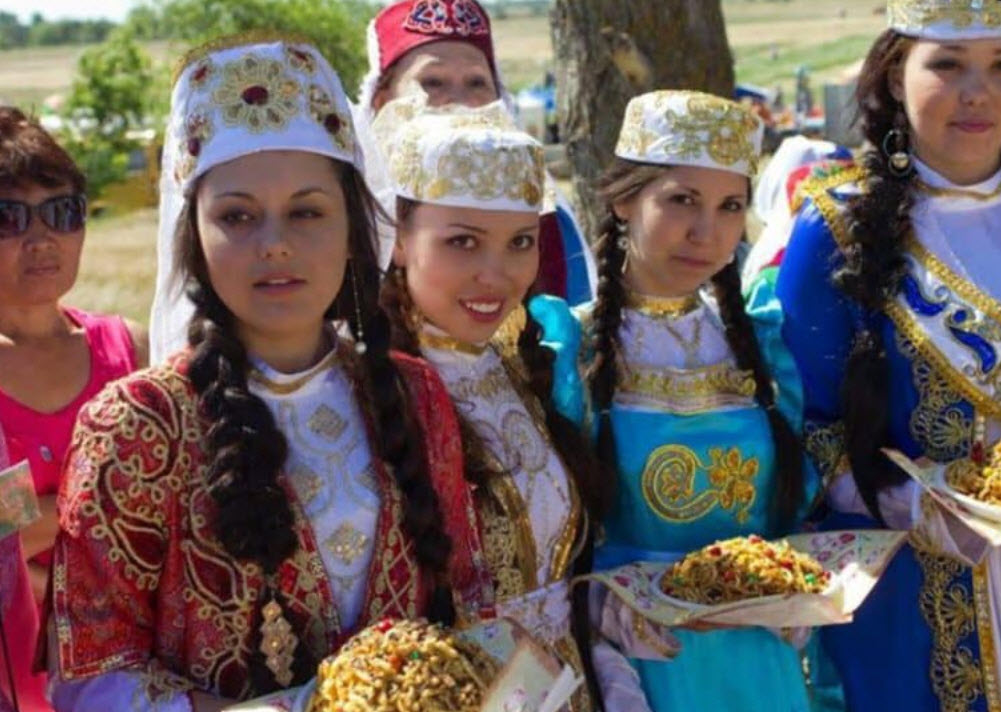The Astrakhan Tatars (Tatar: Əsterxan tatarları, Əsterhan tatarlary, Ashtarkhan tatarları) are an ethnic subgroup within Tatar group. Historically, the Astrakhan Tatars were nomads living in the Astrakhan Khanate (1459-1556) in south-western Russia; a khanate also inhabited by the Nogai Horde. Today, a majority of the Astrakhan Tatar population is still found in south-western Russia, more specificially in the Astrakhan Oblast.
The Astrakhan Tatar subground can be further divided into three divisions: Kundrov Tatars, Karagash Tatars (Karashi Tatars), and the Yurt Tatars.

The Astrakhan Tatars still form a distinctive conglomerate, carrying forth centuries of rich culture, language, and historical traditions. The enrich cultural fabric of Euroasia with their unique linguistic attributes, historical significance, and vibrant cultural practices.
This article will explore the captivating heritage, historical imprints, language aspects, and enduring traditions of the Astrakhan Tatars.
Examples of notable Astrakhan Tatars
On this page:
- Alex Battler – Russian-Canadian scholar and political writer.
- Rinat Dasayev – Russian football coach and a former Soviet goalkeeper.
- Renat Davletyarov – Russian film director, film producer and screenwriter.
- Marziyya Davudova – Russian-born Soviet Azerbaijani actress.
Origins and early history
The Astrakhan Tatars emerged predominantly through the fusion of various Turkic tribes, chiefly descending from the Golden Horde of the 15th century. The Astrakhan Tatars lived in the Astrakhan Khanate (1459-1556) and had a major influence on the Nogais; a Turkic people who also lived there.
The history of the Astrakhan Tatars intertwines with Russia, resulting from Russia’s inclusion of the Astrakhan Khanate in 1556. Subsequently, the dispersion of the Astrakhan Tatars extended across the Volga River Delta and the Caspian Lowland, where they contributed significantly to the development of the region’s economy, particularly in fishing, agriculture, and the fur trade. From the 1600s and onward, the interaction and ethnic blending of the Astrakgan Tatars and the Volga Tatars increased notably.
The Khanate of Astrakhan (Xacitarxan Khanate)
The Khanate of Astrakhan, also known as Xacitarxan Khanate, was a Tatar state that emerged during the break-up of the Golden Horde. The Golden Horde (self-designated as Ulug Ulus) was originally a Mongol and later Turkicized khanate established in the 1200s in the northwestern part of the Mongol Empire.
The Khanate of Astrakhan was located by the mouth of the Volga River, around what is now a modern city also named Astrakhan. Established in the 1460s by Mahmud bin Küchük, the khanate covered the Lower Volga valley and the Volga Delta. It encompassed much of what today is the Astrakhan Oblast, and also the steppeland along the right bank of Volga in present-day Kalmykia.
The leaders of the Khanate of Astrakhan claimed patrilineal descent from Jochi Khan, the eldest son of Genghis Khan.
The Khanate of Astrakhan was strategically located, since this is where the north-south trade route along the Volga River to Persia intersected with the east-west trade route established north of the Caspian Sea.
Language of the Astrakhan Tatars
The Astrakhan Tatars traditionally speak a distinct dialect of the Tatar language called Ästerxan, often corresponding to the Middle or Central dialects. Displaying striking similarities to the Bashkir and Kazakh languages, Ästerxan warrants a significant place in linguistic studies.
Nowadays, many people with Astrakhan ancenstry are instead speaking the Middle Tatar dialect, also known as the Kazan dialect.
The Astrakhan Tatars are predominantly Muslim
Islam is the predominant religion amongst the Astrakhan Tatars and their religious traditions are strongly tied to the Volga Bulgarian civilization. They largely adhere to the Muslim religious holidays, fasting rituals, and the teachings of the Islamic faith. For many Astrakhan Tatars, faith plays a crucial part in their daily lives, influencing aspects such as social customs and dietary choices.
Traditions
The cultural tapestry of the Astrakhan Tatars embodies a line-up of annual festivals, traditional music, dance, and an enticing array of gastronomy. Sabantuy, a traditional summer festival, and Kurban Bayram, a religious festival, are among the most prominent festivities.
Future
In the Russian Census of 2010, most Astrakhan Tatars declared themselves to be just Tatars and few bothered to list themselves specificially as Astrakhan Tatars. Ever since the 1600s, the differences between Astrakhan Tatars and Volga Tatars have been decreasing.
The unique dialect of the Astrakhan Tatarss and some of their intricate cultural practices risk fading into obscurity if not preserved and propagated effectively. National cultural institutions and regional communities are currently intensifying efforts to protect, document and promote the Astrakhan Tatars’ cultural heritage. Among these strategies are academic research, language preservation programs, and cultural festivals that celebrate the Astrakhan Tatars’ legacy.